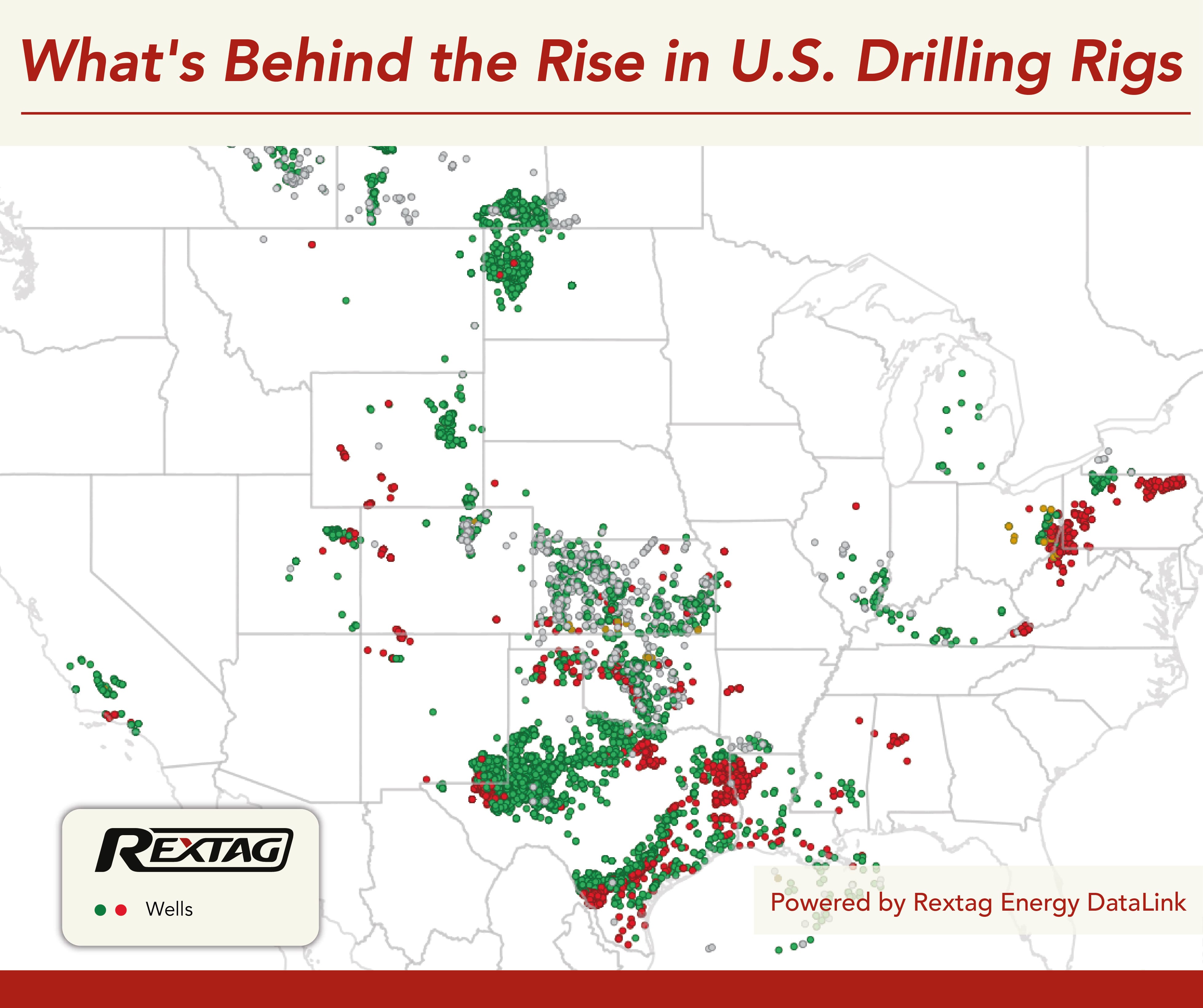Comprehensive Energy Data Intelligence
Information About Energy Companies, Their Assets, Market Deals, Industry Documents and More...
What's Behind the Rise in U.S. Drilling Rigs?
07/10/2024
The total number of drilling rigs actively exploring and producing oil and natural gas in the United States increased to 585 for the week ending July 5, up from 581 the previous week. Despite this recent uptick, the current count still falls short of last year's 680, indicating a slowdown in drilling activities. Analysts suggest that this reduction may reflect greater efficiency among shale producers, who now require fewer rigs. Nonetheless, concerns remain about whether some producers have enough viable drilling land.
Breaking down the numbers, onshore drilling accounted for 562 rigs, slightly up from 560 the week before. Offshore drilling also saw an increase, with 23 rigs operating compared to 21 in the previous week.
Focusing on oil rigs, the count remained steady at 479, unchanged from the previous week, but still below last year's count of 540 and significantly lower than the peak of 1,609 seen in October 2014.
For natural gas, the rig count rose to 101, up from 97 the previous week, yet it still trails the 135 count from the same time last year. This current figure represents a dramatic 94% decrease from the all-time high of 1,606 rigs recorded in 2008.
Examining rig types, vertical drilling rigs held steady at 18 units. The count for horizontal and directional rigs, which includes advanced drilling technologies capable of penetrating dense shale formations, increased slightly from 563 to 567.
In the Permian Basin, the most active region in the U.S., the weekly oil and gas rig count remained steady at 305, matching the previous week but down from 342 the previous year.
Outlook for U.S. Oil and Gas
With the West Texas Intermediate crude trading above $80 per barrel, conditions are currently very favorable for exploration and production operations. However, despite the attractive pricing environment, there has been a noticeable slowdown in drilling activities. This trend may persist as companies in the upstream sector are now focusing more on delivering returns to shareholders rather than increasing production.
In this context, investors looking for medium to long-term opportunities might consider energy stocks like Diamondback Energy, Inc. and Matador Resources Company.
Diamondback Energy, a top Permian Basin operator, has been making significant improvements in well productivity, especially in the Midland Basin. Holding a Zacks Rank #3 (Hold), the company is expected to see continued growth in production volumes. Additionally, the upcoming merger with Endeavor, set to finalize in the fourth quarter of this year, will substantially expand its Permian holdings to about 838,000 net acres. This expansion promises an extensive inventory of prime drilling sites with a break-even oil price below $40 per barrel.
Matador Resources has also been active, entering into a $1.91 billion deal to increase its presence in the Delaware Basin. Slated to close in the late third quarter of 2024, this acquisition will bring Matador's holdings in the region to over 190,000 net acres. As a result, the company anticipates its production will surpass 180,000 barrels of oil equivalent per day, setting the stage for significant growth and enhanced operational scale.
If you are looking for more information about energy companies, their assets, and energy deals, please, contact our sales office mapping@hartenergy.com, Tel. 619-349-4970 or SCHEDULE A DEMO to learn how Rextag can help you leverage energy data for your business.
Diamondback's Viper Energy Acquires $1 Billion in Royalty Interests in the Permian Basin
![$data['article']['post_image_alt']](https://images2.rextag.com/public/blog/186Blog_Viper Energy Secures $1 Billion in Permian.png)
Viper Energy's deal, comprised of cash and equity, secures an additional 2,800 net royalty acres in the Midland Basin and 1,800 in the Delaware Basin. Viper Energy Partners LP, a Diamondback Energy Inc. subsidiary, has inked a deal to acquire mineral and royalty interests in the Permian Basin. The deal, valued at around $1 billion, is with Warwick Capital Partners and GRP Energy Capital. Viper was established by Diamondback with the purpose of owning, purchasing, and capitalizing on oil and natural gas assets in North America, specifically targeting mineral and royalty interests.
TOP 2022 vs 2023 Permian Producers Overview by Rextag
![$data['article']['post_image_alt']](https://images2.rextag.com/public/blog/R242_Blog_Permian Producers Overview by Rextag.png)
The Permian Basin, America's prime oil region, faced significant challenges during the COVID-19 pandemic. The industry saw a drastic reduction in rigs and fracking crews and had to close some operations as oil prices plummeted, leading to widespread restructuring. Now, the Permian is making a strong comeback. Over the last three years, exploration and production companies (E&Ps) have increased their drilling activities. They're focusing on spending wisely and maximizing returns to their investors. The Permian's role is crucial. It was projected to contribute over 5.98 million barrels of oil per day in December, making up about 62% of the total oil production in the Lower 48 states, as per the EIA.
![$data['article']['post_image_alt']](https://images2.rextag.com/public/blog/328_Blog_Why Are Oil Giants Backing Away from Green Energy Exxon Mobil, BP, Shell and more .jpg)
As world leaders gather at the COP29 climate summit, a surprising trend is emerging: some of the biggest oil companies are scaling back their renewable energy efforts. Why? The answer is simple—profits. Fossil fuels deliver higher returns than renewables, reshaping priorities across the energy industry.
![$data['article']['post_image_alt']](https://images2.rextag.com/public/blog/327_Blog_Oil Market Outlook A Year of Growth but Slower Than Before.jpg)
The global oil market is full of potential but also fraught with challenges. Demand and production are climbing to impressive levels, yet prices remain surprisingly low. What’s driving these mixed signals, and what role does the U.S. play?
![$data['article']['post_image_alt']](https://images2.rextag.com/public/blog/326_Blog_USA Estimated Annual Rail CO2 Emissions 2035.jpg)
Shell overturned a landmark court order demanding it cut emissions by nearly half. Is this a victory for Big Oil or just a delay in the climate accountability movement?